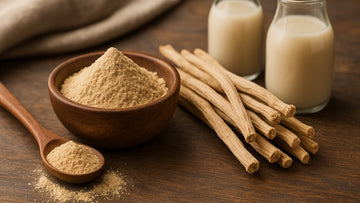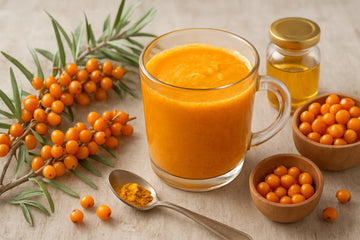In North India, turmeric is commonly called “haldi,” a word derived from the Sanskrit word haridra, and in the south it is called “Manjal,” a word that is frequently used in ancient Tamil literature. It is an important spice in the Indian kitchens and its use dates back nearly 4000 years to the Vedic culture in India, where it was used as a culinary spice and had some religious significance.
India currently meets an annual production demand of about 8 lakh MT of cured turmeric. It is the largest producer of turmeric in the world and contributes to almost 80% of the total production. About 92% of the produce is consumed domestically and the remaining 8% is exported.
Medicinal Properties of Turmeric
The antiseptic and anti-inflammatory properties of turmeric have been known to Indians for centuries and with the advent of modern technology, awareness of its nutraceutical value and use as a medicine to heal many health disorders like liver problems, digestive disorders, skin diseases and wound healing has been continuously increasing. It is commonly used as a preservative and food colouring, and is one of the basic ingredients in curry powder.
Curcumin is the active ingredient in turmeric which has been shown to have a wide range of therapeutic effects.
Varieties of Turmeric
Today, approximately 30 varieties have been recognized in the type of Curcuma in which turmeric belongs. Some of the most popular ones are –
- Alleppey Finger – Kerala
- Erode and Salem turmeric – Tamil Nadu
- Rajapore and Sangli turmeric – Maharashtra
- Nizamabad Bulb – Andhra Pradesh
- Lakadong – Meghalaya
Note: Lakadong is very famous for its high curcumin content of more than 7.5%

Lakadong Turmeric – The Gem of Meghalaya
Meghalaya has natural advantages in growing a variety of spices of which the prominent ones are turmeric, ginger, chilli, black-pepper and bay-leaf. The Lakadong turmeric grown in the state is unique in the world with the potential to change the lives of countless farmers as well as the consumers.
Today, with the efforts of the Government of Meghalaya and people like Padma – Shree awardee Trinity Sahoo, Lakadong turmeric from Jaiñtia Hills, Meghalaya, Lakadong Turmeric is being sought after for its use in the cosmetic, pharmaceutical and food industry.
Being one of the finest turmeric varieties in the world – the famous “Lakadong” variety has a curcumin content of more than 7% (almost 4% higher than the other varieties).
What are the differences Between Lakadong Turmeric & other Turmeric varieties?
All turmeric powders may appear the same to the uninitiated.
A closer examination, however, will reveal a good many differences between Lakadong turmeric and ordinary turmeric.
- The most glaring difference when it comes to Lakadong is the level of curcumin – the active constituent within turmeric that is responsible for its therapeutic properties. With an average content of 7.5%, Lakadong far exceeds the 3% normally seen with other varieties.
- Lakadong turmeric is recognised for the vibrant yellow colour that comes from the high curcumin content. This unique colour makes your food look appealing to the eye and more appetizing, especially if you’re a foodie! Other turmeric types, by comparison, give the food a not so appealing, even dull, appearance.
- As you add your Lakadong turmeric to your curries the room is immediately filled with beautiful scents of earthy, delectable treats. Your curries’ aroma wafts through the air and right into the mouths and noses of those present. And it makes them feel good; a sense of satisfaction they received goes above and beyond what other turmeric powders could ever provide.
Lakadong Turmeric vs. Regular Turmeric – Comparison Table
| Feature | Lakadong Turmeric | Regular Turmeric |
| Curcumin Content | ~7.5% (High) | ~2–3% (Moderate to Low) |
| Color | Vibrant deep yellow to orange | Pale yellow to dull orange |
| Aroma | Strong, earthy, gingery, and fresh | Mild or indistinct aroma |
| Taste | Rich, slightly bitter with depth of flavor | Bland or sometimes chalky due to adulteration |
| Purity | Usually organic, often single-origin and unadulterated | May be blended or adulterated with fillers like talc |
| Source/Origin | Jaintia Hills, Meghalaya, India | Grown widely across India (Kerala, Tamil Nadu, Maharashtra, etc.) |
| Therapeutic Value | High—used in wellness, cosmetics, and pharma industries | Moderate—mostly culinary uses |
| Processing | Hand-harvested, traditionally sun-dried | Often machine-processed |
| Uses | Food, nutraceuticals, skincare, and herbal medicine | Primarily culinary and food coloring |
| Visual Appeal in Food | Bright, appetizing look in curries | Duller visual presentation |
| Market Demand | Premium product, increasing global demand | Standard market availability |
| Price | Higher due to purity and potency | Lower, mass-market pricing |
What are the easy home tests I can do to check the quality of turmeric?
Here are some of the Visual, Physical and Smell Tests that can be easily conducted at home
These measures might prove to be less precise than some of the other methods, but they can offer more of an insight into turmeric quality and if it is genuine.
The colour test
In loose powder, the one sure way to check its genuineness is to inspect its physical and visual appearance. This can be tricky sometimes. But if you buy from known and trusted sellers you are less likely to be cheated. The colour of good Lakadong turmeric is a fluorescent deep orange to bright yellow. If the colour is somewhat lighter or dull yellow in shade, chances are it is of lower quality or purity.
The palm test
Put a pinch of turmeric powder on the palm of your left hand. With your right thumb rub the powder for a few seconds. The good powder will stick to your palm, leaving a deep bright orange tint on it. Now tilt your left palm sideways perpendicular to the ground. Much of the powder will remain stuck on your palm. If more of it falls it may have been mixed with other ingredients like chalk.
The smell test
Good turmeric powder will have a distinct, but mild, earthy aroma and turmeric users will immediately recognize a gingery and orangey scent in it. Bad turmeric will not emit such an aroma. Rather it might have some indistinct smell that doesn’t quite give the flavour of turmeric. This may be mixed with some adulterant like talc or corn flour or with some very poor-quality turmeric.
Turmeric Water test (for foreign ingredients)
At home, you can take a level teaspoon of turmeric powder and add it to a glass tumbler of lukewarm water, without stirring. Let it stand for about 15-20 minutes to settle down. If the turmeric is genuine it will settle at the bottom and the water will be clear. But if there are foreign ingredients the water will cloud.
Examining Good Quality Rhizome
Rhizome comparison Turmeric Test – We can also identify the quality of turmeric at the rhizome level. This involves knowing the actual rhizomes species to determine the quality of turmeric.
Lakadong rhizome has fingers like those in another turmeric (and ginger) species. They look very much alike in shape and structure. The roots, however, are the tell-tale signs.
Lakadong roots are thin, long and parallel in diameter throughout their lengths. Any other turmeric will have roots that are thicker in diameter at the base. The thickness tapers off towards the tip.
FAQs
1. What is Lakadong turmeric and why is it special?
Lakadong turmeric is a high-quality variety grown in Meghalaya, India, known for its rich curcumin content (over 7.5%)—much higher than regular turmeric. This gives it stronger medicinal properties, a brighter color, and a deeper aroma.
2. How is Lakadong turmeric different from regular kitchen turmeric?
Lakadong turmeric contains more than double the curcumin content (7.5% vs. 3%), making it more potent, aromatic, and vibrant. It’s also purer and less likely to be adulterated.
3. What are the health benefits of turmeric and curcumin?
Turmeric has been used for centuries for its antiseptic, anti-inflammatory, and healing properties. Curcumin, the active compound in turmeric, supports liver health, digestion, skin conditions, and wound healing.
4. How can I test the quality of turmeric at home?
You can use simple home tests like the palm test, smell test, water test, and color inspection. Good turmeric leaves a deep orange tint, smells earthy and gingery, and settles cleanly in water.
5. Why is turmeric important in Indian cuisine and culture?
Turmeric has been used in Indian cooking for over 4,000 years and also holds religious and cultural importance. It’s a core spice in curries and valued for its color, flavor, and health benefits.
6. Where is Lakadong turmeric grown and who promotes it?
Lakadong turmeric is grown in the Jaintia Hills region of Meghalaya. It is promoted by the Government of Meghalaya and notable individuals like Padma Shri awardee Trinity Saioo to boost local farming and global reach.
7. How to use Lakadong turmeric?
Lakadong turmeric can be used in a variety of ways due to its high curcumin content and strong flavor. You can add it to curries, golden milk (haldi doodh), smoothies, soups, or teas for enhanced color, taste, and health benefits. For best results, combine it with black pepper and healthy fats like ghee or coconut oil to boost curcumin absorption.
8. How many types of turmeric in India?
India is home to around 30 recognized types of turmeric, each varying in curcumin content, color, aroma, and regional origin. Popular varieties include Lakadong (Meghalaya), Alleppey Finger (Kerala), Erode and Salem (Tamil Nadu), Rajapore and Sangli (Maharashtra), and Nizamabad Bulb (Andhra Pradesh).
9. How to use white turmeric for skin whitening?
Mix white turmeric powder with yogurt or honey to make a paste and apply it to your face. Leave it on for 10–15 minutes, then rinse off for a natural glow.
10. How to identify pure turmeric powder?
To identify pure turmeric powder, check for a bright yellow-orange color and a strong, earthy aroma. You can also do a water test—pure turmeric will settle at the bottom without clouding the water, indicating no adulterants.
11. What is Lakadong turmeric rhizome?
Lakadong turmeric rhizome is the raw root form of the Lakadong turmeric variety, grown mainly in Meghalaya's Jaintia Hills. It is known for its thin, long, and uniformly shaped fingers and contains over 7.5% curcumin, making it one of the most potent and sought-after turmeric types.










